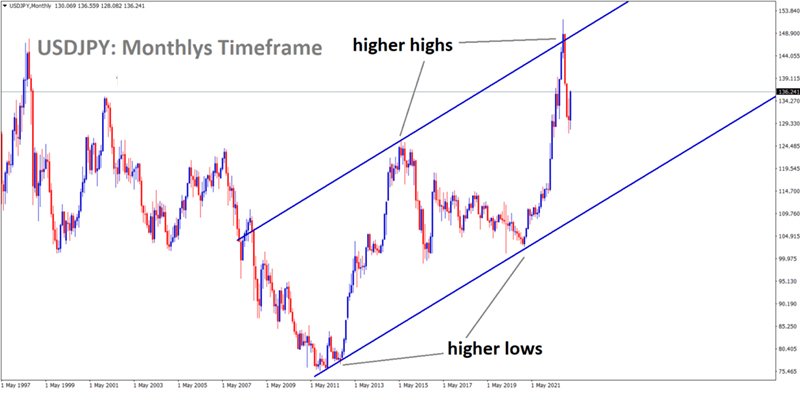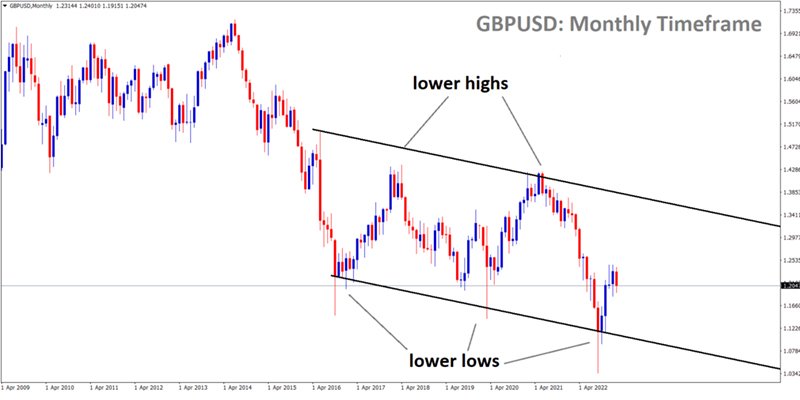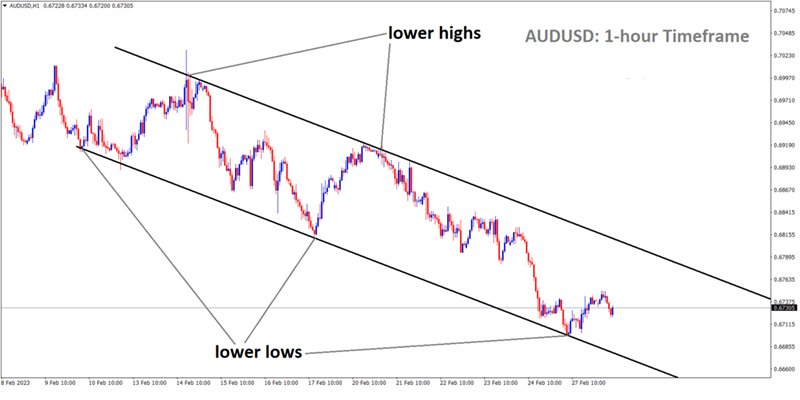US Dollar Awaits Upcoming CB Consumer Confidence Data

USDJPY is moving in an Ascending channel and the market has fallen from the higher high area of the channel.
On Tuesday, the United States Conference Board will publish its Consumer Confidence indicator, which is anticipated to have increased in February to 108.5 from 107.1 in January. The figure for December was revised upwards, leading to a higher reading in December 2022. However, the figure for January was revised downwards, as consumers had a more positive outlook on the current situation but were pessimistic about their income, business, and labor market conditions expectations. In conclusion, consumers’ expectations for inflation moved up slightly from 6.6% to 6.8% over the next 12 months, despite the fact that inflation forecasts are still down from their peak of 7.9% last observed in June.
US Suffers High Inflation
On Friday, the market reacted negatively to data showing that inflation increased in the United States over the previous month. Investors were concerned that this might prompt the Federal Reserve to increase interest rates in a more aggressive manner.

EURUSD is moving in the Descending channel and the market has rebounded from the lower low area of the channel.
While investors wait to see how much the Federal Reserve and other central banks will continue to raise borrowing costs to contain inflation, the forecast for global interest rates continues to dominate the direction of the market.

The price index for personal consumption expenditures (PCE), which is the preferred measure of inflation used by the Fed, increased by 5.4 percent from January 2022 to February 2022, according to data provided by the Commerce Department. This is an increase from the 4.6 percent annual increase seen in December.
US Surprising Employment Data
Despite the fact that official statistics shows the jobless rate is at its lowest level in decades, major companies in the United States, including fast-food chains and armaments manufacturers, are reporting a dramatic increase in hiring circumstances. The revelation of unexpectedly solid job growth data at the beginning of this month caused a dramatic decrease in stock and bond prices.

GBPUSD is moving in the Descending channel and the market has rebounded from the lower low area of the channel.
Investors anticipated that growing salaries would force the Federal Reserve to raise interest rates further, so they sold stocks and bonds. Chipotle and Starbucks, two other high street brands, have both claimed gains in staff retention. According to Starbucks’ chief reinvention officer Frank Britt, this will help minimize the expenses associated with training new employees and will help operations remain stable. The improvement is not confined to lower-paying businesses such as restaurants and motels but has occurred across the board.
US PMI Data
According to a poll, the level of economic activity in the United States surprisingly increased in February to a level that was the most it had been in eight months, reaching 50.2 after reaching a final reading of 46.8 in January. A reading of the PMI that is greater than 50 implies expansion, whilst a number that is less than 50 suggests contraction. It comes on the heels of recent strong data on retail sales, the job market, and factory production, all of which point to sustained momentum in the economy at the start of the year.

“Today’s PMI releases show a large portion of the U.S. economy is still proving more resilient than expected, particularly the services sector, but the housing market remains challenged as evidenced by the surprise decline in existing home sales,” said Erik Nelson, macro strategist at Wells Fargo Securities in London.
US Housing Market Crash
Since June, the market value of U.S. homeowners’ homes has dropped by an astounding $2.3 trillion as a result of higher interest rates driving down demand in the once red-hot housing market. Furthermore, many economists predict that the decline will continue throughout the year because mortgage costs will remain elevated and will keep sidelining potential buyers.
The overall value of houses in the United States dropped from a record high of $47.7 trillion in June to around $45.3 trillion at the end of the previous year. This decline is the steepest drop from June to December since the subprime mortgage crisis began to unravel in 2008. The hardest-hit areas include those that were adversely affected by waves of technology layoffs and skyrocketing prices during the pandemic.

AUDUSD is moving in the Descending channel and the market has rebounded from the lower low area of the channel.
These areas include San Francisco, Oakland, and New York City, all of which saw a decrease in home prices year over year. San Francisco saw a decrease of nearly 7%, while Oakland saw a decrease of 4.5 percent, and New York City saw a decrease of 1%. During the epidemic, historically low mortgage rates and record high savings fueled a home market boom. Nevertheless, the Federal Reserve’s rate rises brought in a precipitous decline in housing demand, which has just lately started to normalize.
US Treasury Secretary Janet Yellen Speech
The US Secretary of Treasury Janet Yellen recently gave a speech in India where she discussed the Ukraine-Russia war and its long-term impacts on the global economy. She reveals, “While there are significant headwinds, it’s fair to say that the global economy is in a better place today than many predicted just a few months ago. In the fall, many were worried about a sharp economic slowdown across the world.

NZDUSD is moving in the Descending channel and the market has rebounded from the lower low area of the channel.
The challenges we face are real, and the future is always uncertain. But the outlook has improved since we gathered in the fall. In its most recent estimates, the IMF forecasts global growth of 3.2 percent during 2023 – a notable upgrade from its October report. In the United States, our economy remains resilient.”

“Year-on-year headline inflation has moderated over the past few months – as supply chain pressures have eased and global imbalances have subsided. At the same time, our labor market remains strong. In January, U.S. unemployment hit a low not seen in over a half-century. The progress on our global macroeconomy is a result of our collective work. And it underscores the importance of redoubling our efforts going forward. Our progress has also been made possible through our actions to mitigate spillovers from Russia’s war on Ukraine. Vladimir Putin’s immoral war has exacerbated the stress on our food systems. Since last year, the United States has committed more than $13 billion in humanitarian and food security assistance.”
US Dollar Awaits Upcoming CB Consumer Confidence Data

USDJPY is moving in an Ascending channel and the market has fallen from the higher high area of the channel.
On Tuesday, the United States Conference Board will publish its Consumer Confidence indicator, which is anticipated to have increased in February to 108.5 from 107.1 in January. The figure for December was revised upwards, leading to a higher reading in December 2022. However, the figure for January was revised downwards, as consumers had a more positive outlook on the current situation but were pessimistic about their income, business, and labor market conditions expectations. In conclusion, consumers’ expectations for inflation moved up slightly from 6.6% to 6.8% over the next 12 months, despite the fact that inflation forecasts are still down from their peak of 7.9% last observed in June.
US Suffers High Inflation
On Friday, the market reacted negatively to data showing that inflation increased in the United States over the previous month. Investors were concerned that this might prompt the Federal Reserve to increase interest rates in a more aggressive manner.

EURUSD is moving in the Descending channel and the market has rebounded from the lower low area of the channel.
While investors wait to see how much the Federal Reserve and other central banks will continue to raise borrowing costs to contain inflation, the forecast for global interest rates continues to dominate the direction of the market.

The price index for personal consumption expenditures (PCE), which is the preferred measure of inflation used by the Fed, increased by 5.4 percent from January 2022 to February 2022, according to data provided by the Commerce Department. This is an increase from the 4.6 percent annual increase seen in December.
US Surprising Employment Data
Despite the fact that official statistics shows the jobless rate is at its lowest level in decades, major companies in the United States, including fast-food chains and armaments manufacturers, are reporting a dramatic increase in hiring circumstances. The revelation of unexpectedly solid job growth data at the beginning of this month caused a dramatic decrease in stock and bond prices.

GBPUSD is moving in the Descending channel and the market has rebounded from the lower low area of the channel.
Investors anticipated that growing salaries would force the Federal Reserve to raise interest rates further, so they sold stocks and bonds. Chipotle and Starbucks, two other high street brands, have both claimed gains in staff retention. According to Starbucks’ chief reinvention officer Frank Britt, this will help minimize the expenses associated with training new employees and will help operations remain stable. The improvement is not confined to lower-paying businesses such as restaurants and motels but has occurred across the board.
US PMI Data
According to a poll, the level of economic activity in the United States surprisingly increased in February to a level that was the most it had been in eight months, reaching 50.2 after reaching a final reading of 46.8 in January. A reading of the PMI that is greater than 50 implies expansion, whilst a number that is less than 50 suggests contraction. It comes on the heels of recent strong data on retail sales, the job market, and factory production, all of which point to sustained momentum in the economy at the start of the year.

“Today’s PMI releases show a large portion of the U.S. economy is still proving more resilient than expected, particularly the services sector, but the housing market remains challenged as evidenced by the surprise decline in existing home sales,” said Erik Nelson, macro strategist at Wells Fargo Securities in London.
US Housing Market Crash
Since June, the market value of U.S. homeowners’ homes has dropped by an astounding $2.3 trillion as a result of higher interest rates driving down demand in the once red-hot housing market. Furthermore, many economists predict that the decline will continue throughout the year because mortgage costs will remain elevated and will keep sidelining potential buyers.
The overall value of houses in the United States dropped from a record high of $47.7 trillion in June to around $45.3 trillion at the end of the previous year. This decline is the steepest drop from June to December since the subprime mortgage crisis began to unravel in 2008. The hardest-hit areas include those that were adversely affected by waves of technology layoffs and skyrocketing prices during the pandemic.

AUDUSD is moving in the Descending channel and the market has rebounded from the lower low area of the channel.
These areas include San Francisco, Oakland, and New York City, all of which saw a decrease in home prices year over year. San Francisco saw a decrease of nearly 7%, while Oakland saw a decrease of 4.5 percent, and New York City saw a decrease of 1%. During the epidemic, historically low mortgage rates and record high savings fueled a home market boom. Nevertheless, the Federal Reserve’s rate rises brought in a precipitous decline in housing demand, which has just lately started to normalize.
US Treasury Secretary Janet Yellen Speech
The US Secretary of Treasury Janet Yellen recently gave a speech in India where she discussed the Ukraine-Russia war and its long-term impacts on the global economy. She reveals, “While there are significant headwinds, it’s fair to say that the global economy is in a better place today than many predicted just a few months ago. In the fall, many were worried about a sharp economic slowdown across the world.

NZDUSD is moving in the Descending channel and the market has rebounded from the lower low area of the channel.
The challenges we face are real, and the future is always uncertain. But the outlook has improved since we gathered in the fall. In its most recent estimates, the IMF forecasts global growth of 3.2 percent during 2023 – a notable upgrade from its October report. In the United States, our economy remains resilient.”

“Year-on-year headline inflation has moderated over the past few months – as supply chain pressures have eased and global imbalances have subsided. At the same time, our labor market remains strong. In January, U.S. unemployment hit a low not seen in over a half-century. The progress on our global macroeconomy is a result of our collective work. And it underscores the importance of redoubling our efforts going forward. Our progress has also been made possible through our actions to mitigate spillovers from Russia’s war on Ukraine. Vladimir Putin’s immoral war has exacerbated the stress on our food systems. Since last year, the United States has committed more than $13 billion in humanitarian and food security assistance.”

